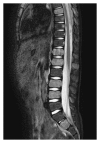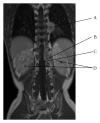Paravertebral Burkitt's Lymphoma in a Child: An Unusual Presentation
- PMID: 23251186
- PMCID: PMC3522419
- DOI: 10.1155/2012/891714
Paravertebral Burkitt's Lymphoma in a Child: An Unusual Presentation
Abstract
Paravertebral malignant tumors constitute 4.8% of cancer cases in pediatric oncology and are mostly composed of neuroblastoma (46.4%) and soft tissue sarcomas (35.7%). We describe the case of a Caucasian 6-year-old boy who was admitted for middle back pain radiated to limbs and progressively increasing weakness of the legs, suggesting a spinal cord disease. The exploration revealed two paravertebral masses extending through the neural foraminae into the epidural space. The association with elevated serum neuron specific enolase suggested at first the diagnosis of neuroblastoma, but the pathological examination revealed a Burkitt's lymphoma. This is a rare location of sporadic Burkitt's lymphoma with neurologic syndrome as first symptoms.
Figures





Similar articles
-
Spinal Burkitt's lymphoma in adults.Clin Lymphoma Myeloma. 2006 Jan;6(4):333-6. doi: 10.3816/CLM.2006.n.009. Clin Lymphoma Myeloma. 2006. PMID: 16507212
-
Spinal Burkitt's Lymphoma Mimicking Dumbbell Shape Neurogenic Tumor: A Case Report and Review of the Literature.Korean J Spine. 2015 Sep;12(3):221-4. doi: 10.14245/kjs.2015.12.3.221. Epub 2015 Sep 30. Korean J Spine. 2015. PMID: 26512290 Free PMC article.
-
Sporadic Burkitt's Lymphoma of the Hypopharynx: A Case Report.Saudi J Med Med Sci. 2019 May-Aug;7(2):114-117. doi: 10.4103/sjmms.sjmms_179_17. Epub 2019 Apr 12. Saudi J Med Med Sci. 2019. PMID: 31080393 Free PMC article.
-
HIV-related non-Hodgkin Lymphoma. Case report and review of the literature.Acta Biomed. 2019 Jan 15;89(4):576-580. doi: 10.23750/abm.v89i4.6627. Acta Biomed. 2019. PMID: 30657128 Free PMC article. Review.
-
Challenges in the management of Burkitt's lymphoma.Clin Lymphoma. 2002 Dec;3 Suppl 1:S19-25. doi: 10.3816/clm.2002.s.011. Clin Lymphoma. 2002. PMID: 12521385 Review.
Cited by
-
Children with back pain - a radiologist's approach.Pol J Radiol. 2023 Aug 18;88:e371-e378. doi: 10.5114/pjr.2023.130977. eCollection 2023. Pol J Radiol. 2023. PMID: 37701175 Free PMC article.
-
Primary epidural sporadic Burkitt lymphoma in a 3-year-old: Case report and literature review.Surg Neurol Int. 2022 Mar 25;13:106. doi: 10.25259/SNI_1172_2021. eCollection 2022. Surg Neurol Int. 2022. PMID: 35399880 Free PMC article.
References
-
- Gunes D, Uysal KM, Cetinkaya H, et al. Paravertebral malignant tumors of childhood: analysis of 28 pediatric patients. Child’s Nervous System. 2009;25(1):63–69. - PubMed
-
- Ortega JA, Wharam M, Gehan EA, et al. Clinical features and results of therapy for children with paraspinal soft tissue sarcoma: a report of the intergroup rhabdomyosarcoma study. Journal of Clinical Oncology. 1991;9(5):796–801. - PubMed
-
- Cairo MS, Sposto R, Perkins SL, et al. Burkitt’s and Burkitt-like lymphoma in children and adolescents: a review of the children’s cancer group experience. British Journal of Haematology. 2003;120(4):660–670. - PubMed
-
- Daley MF, Partington MD, Kadan-Lottick N, Odom LF. Primary epidural burkitt lymphoma in a child: case presentation and literature review. Pediatric Hematology and Oncology. 2003;20(4):333–338. - PubMed
LinkOut - more resources
Full Text Sources

